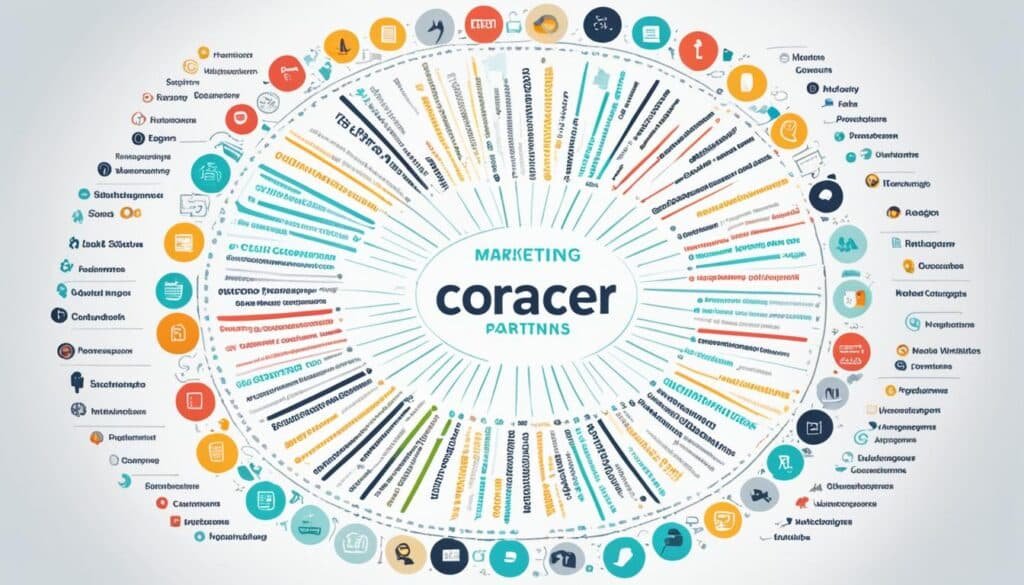Welcome to our ultimate guide to marketing 360 strategies! In today’s digital landscape, businesses need to leverage all available channels to reach their target audience and drive business growth. This is where marketing 360 strategies come into play. By adopting a holistic approach that combines traditional and digital marketing channels, businesses can maximize opportunities and create a consistent brand presence throughout the buyer’s journey.
Marketing 360 strategies encompass a wide range of tactics and techniques that aim to engage the target audience at various touchpoints. Whether it’s SEO, PPC advertising, social media, content marketing, email marketing, print media, TV and radio commercials, or face-to-face marketing, a well-executed marketing 360 strategy ensures that businesses are present wherever their customers are.
The key to a successful marketing 360 strategy lies in understanding the target audience, conducting thorough customer research, and aligning goals with the customer journey. By identifying the most effective marketing channels for each stage of the journey, businesses can create personalized and impactful campaigns that drive results.
In this comprehensive guide, we will delve into the intricacies of marketing 360 strategies, explaining what they are, why businesses should use them, how to build a results-driven strategy, the channels to incorporate, the benefits they offer, and the key components that make them successful. Additionally, we will explore the intersection of marketing 360 with integrated marketing strategies and how businesses can create a comprehensive connection with their customers.
Key Takeaways:
- Marketing 360 strategies combine traditional and digital channels to engage the target audience.
- They ensure consistent branding across all marketing touchpoints.
- Building a results-driven strategy involves understanding the target audience and the customer journey.
- The success of a marketing 360 strategy depends on choosing the right channels to reach the target audience.
- Benefits include increased brand visibility, improved customer experience, efficiency, and data-driven decision-making.
What is 360 Marketing and Why Use It?
360 marketing is a comprehensive approach that combines traditional and digital marketing channels to reach the target audience wherever they are. It leverages multiple touchpoints throughout the buyer’s journey to engage customers effectively. By adopting a 360 marketing strategy, businesses can ensure consistent messaging and branding across all channels, enhancing brand recognition and trust.
A 360 marketing approach enables businesses to connect with customers at every stage of their buyer’s journey. From initial awareness to post-purchase support, this strategy maximizes opportunities for engagement and conversions. By leveraging multiple channels such as online and offline platforms, businesses can create a cohesive and impactful customer experience.
Consistency is key in 360 marketing. By delivering a consistent brand message across all touchpoints, businesses can reinforce their brand identity and instill trust in their target audience. This consistent branding helps to build brand recognition and loyalty, leading to long-term business growth.
In today’s digital age, the buyer’s journey has become more complex, with customers interacting with brands through various channels and devices. A 360 marketing strategy allows businesses to meet customers where they are, regardless of the channel they prefer. This comprehensive approach ensures that businesses remain competitive and relevant in the ever-evolving marketing landscape.
Benefits of 360 Marketing
A 360 marketing strategy offers numerous benefits, including:
- Enhanced Brand Visibility: By utilizing multiple channels, businesses can increase their brand’s visibility and reach a wider audience.
- Improved Customer Experience: 360 marketing ensures a seamless and consistent customer experience across all touchpoints, enhancing customer satisfaction.
- Efficiency in Resource Allocation: By strategically targeting multiple channels, businesses can allocate their marketing resources efficiently for maximum impact.
- Data-Driven Decision-Making: 360 marketing allows businesses to collect and analyze data from multiple sources, enabling informed decision-making and optimization.
- Integrated Marketing Approach: By integrating marketing efforts across multiple channels, businesses can create a cohesive and synchronized marketing approach.
By embracing 360 marketing strategies, businesses can amplify their marketing efforts, engage customers throughout their buyer’s journey, and drive sustainable business growth.
How to Build a Results-Driven 360 Marketing Strategy
To build a successful 360 marketing strategy, it is crucial to understand your target audience, conduct thorough customer research, and define the purpose of your campaign. By mapping out the customer journey and identifying the most effective marketing channels, you can reach your target audience at each stage of their journey. Aligning your goals and campaigns with customer preferences and behaviors will ensure the creation of a powerful 360 marketing strategy.
When building your 360 marketing strategy, one of the key components is understanding your target audience. Conducting detailed customer research will help you gain insights into their needs, motivations, and pain points. By understanding your audience’s demographics, interests, and online behavior, you can tailor your messaging and marketing efforts to resonate with them effectively.
Defining the purpose of your campaign is another critical step in building a results-driven 360 marketing strategy. Whether your goal is to increase brand awareness, generate leads, or drive sales, having a clear purpose will guide your marketing decisions and ensure that your efforts are aligned with your overall business objectives.
Mapping out the customer journey is essential in a 360 marketing strategy. By identifying the touchpoints and interactions your customers have with your brand throughout their journey, you can create targeted campaigns that address their needs and move them closer to conversion. This can include awareness-building activities at the top of the funnel, nurturing leads in the middle, and providing a seamless experience during the purchase process.
Selecting the most effective marketing channels is crucial in reaching your target audience at each stage of their journey. Different channels, such as social media, search engine optimization (SEO), email marketing, content marketing, and paid advertising, can be used strategically to engage with your audience in the most relevant and impactful ways.
In order to build a results-driven 360 marketing strategy, it’s important to align your goals and campaigns with your customer’s preferences and behaviors. Use customer insights and data to ensure your messaging, content, and offers are tailored to their needs and motivations.
By implementing these steps and creating a comprehensive 360 marketing strategy, you can effectively engage with your target audience across multiple marketing channels, drive brand awareness, generate leads, and ultimately, achieve your business objectives.
Channels to Use in a 360 Marketing Strategy
The success of a 360 marketing strategy relies on choosing the right marketing channels to reach the target audience. By utilizing a combination of diverse channels, businesses can effectively engage with their customers at various touchpoints. Here are some key marketing channels that can enhance the effectiveness of a 360 marketing strategy:
1. SEO (Search Engine Optimization)
Obtaining online visibility is crucial for businesses in the digital era. SEO focuses on optimizing website content and structure to improve organic search rankings. By incorporating relevant keywords, meta tags, and high-quality content, businesses can attract more organic traffic and enhance their online presence.
2. PPC (Pay-Per-Click) Advertising
PPC advertising allows businesses to display targeted ads on search engines and other platforms. By bidding on specific keywords, businesses can drive immediate traffic and increase brand awareness. With well-crafted ad copies and optimized landing pages, PPC advertising can generate quick results and drive conversions.
3. Social Media
Social media platforms offer a vast reach and provide an opportunity for businesses to create engaging content and build meaningful relationships with their audience. Through regular updates, engaging posts, and interactive features, businesses can increase brand visibility, drive website traffic, and foster customer loyalty.
4. Content Marketing
Creating valuable and relevant content is essential for attracting and engaging the target audience. Content marketing includes various forms such as blog posts, infographics, videos, and podcasts. By offering educational and informative content, businesses can position themselves as industry experts and drive customer engagement.
5. Email Marketing
Email marketing is a powerful tool for personalized communication with customers. By segmenting the audience and sending targeted emails, businesses can nurture leads, promote products or services, and drive conversions. Personalized emails that offer valuable content and exclusive offers can establish strong relationships with customers.
6. Print Media
While digital channels dominate the marketing landscape, print media still holds relevance, especially for localized targeting. Print ads, brochures, flyers, and direct mailings can effectively reach specific demographics and provide tangible experiences for customers.
7. TV and Radio Commercials
Television and radio commercials offer broad awareness and are excellent for reaching a wide audience. By creating captivating and memorable ads, businesses can leave a lasting impact on viewers and listeners. Strategic placements on popular TV channels and radio stations can maximize brand exposure.
8. Face-to-Face Marketing
Face-to-face marketing involves direct interactions with potential customers. This can include trade shows, conferences, exhibitions, and networking events. By engaging in personal conversations and showcasing products or services, businesses can establish trust, gather valuable feedback, and build long-term relationships.
By strategically combining these marketing channels in a 360 marketing strategy, businesses can create a cohesive and impactful marketing approach that reaches customers through various mediums and touchpoints.
Benefits of a 360 Marketing Strategy

A successful 360 marketing strategy offers several benefits for businesses, enabling them to enhance their brand visibility, improve customer experience, achieve greater efficiency in resource allocation, and make data-driven decisions. By integrating marketing efforts across multiple channels, businesses can create a seamless and cohesive customer experience that drives brand loyalty and business growth.
Increased Brand Visibility
With a 360 marketing strategy, businesses can amplify their brand visibility across various channels, reaching a broader audience and increasing their market presence. By leveraging different marketing channels such as social media, search engine optimization (SEO), and email marketing, businesses can establish a consistent brand message and gain more exposure, leading to increased brand recognition and recall.
Improved Customer Experience
By integrating marketing efforts across all touchpoints, businesses can deliver a more personalized and seamless customer experience. A 360 marketing strategy enables businesses to understand their customers’ preferences and behavior throughout the buyer’s journey. By leveraging customer data and insights, businesses can tailor their marketing messages and interactions, creating a cohesive and satisfying experience for their customers.
Greater Efficiency in Resource Allocation
A 360 marketing strategy allows businesses to allocate their resources more efficiently by optimizing their marketing activities across multiple channels. By understanding the effectiveness and ROI of each channel, businesses can allocate their budget, time, and effort on the channels that yield the best results. This data-driven approach ensures that businesses make informed decisions and invest their resources where they have the highest impact.
Data-Driven Decision-Making
A 360 marketing strategy leverages data and analytics to drive decision-making. By tracking and analyzing customer behavior, engagement metrics, and campaign performance, businesses can derive valuable insights that inform their future marketing strategies. This data-driven approach allows businesses to optimize their marketing efforts, refine their messaging, and adapt to customer preferences in real-time, leading to more effective and impactful marketing campaigns.
Integrating marketing efforts across multiple channels with a 360 marketing strategy enables businesses to create a holistic and comprehensive approach to marketing. By maximizing brand visibility, improving customer experience, increasing efficiency, and embracing data-driven decision-making, businesses can leverage the power of integrated marketing to drive brand growth and success.
Key Components of a Successful 360 Marketing Strategy

A successful 360 marketing strategy encompasses various key components that work together to create a comprehensive and effective approach. By incorporating these components, businesses can optimize their marketing efforts and drive success in the digital landscape. The key components of a successful 360 marketing strategy include:
Market Research
Market research is a crucial component of a 360 marketing strategy as it enables businesses to understand their target audience better. By conducting thorough market research, businesses can gather valuable insights into customer preferences, behaviors, and needs. This information helps in tailoring marketing campaigns that resonate with the target audience, ultimately leading to improved engagement and conversions.
Product Positioning
Product positioning involves differentiating a business’s offerings from its competitors in the market. By clearly defining and highlighting the unique value and benefits of their products or services, businesses can effectively position themselves as a preferred choice among customers. A well-defined product positioning strategy helps in creating a distinct brand image and attracting the target audience.
Pricing Strategy
A well-thought-out pricing strategy plays a vital role in a successful 360 marketing strategy. The right pricing strategy ensures that businesses strike a balance between profitability and customer value. It involves thorough analysis of market dynamics, competitive pricing, and customer perceptions to determine optimal pricing levels that generate sales while maintaining customer satisfaction and brand perception.
Channel Strategy
Channel strategy refers to the careful selection of marketing channels to reach the target audience effectively. It involves identifying the channels that align with the target audience’s habits and behaviors, whether it’s through online platforms, social media, traditional media, or offline marketing channels. This strategic approach helps businesses maximize their reach and engagement with the target audience.
Promotional Plan
A comprehensive promotional plan is essential to creating brand awareness and attracting potential customers. It includes a strategic mix of advertising, public relations, content marketing, social media campaigns, and other promotional activities tailored to the target audience and marketing channels. A well-executed promotional plan helps businesses generate interest, drive traffic, and increase brand visibility.
Sales Strategy
A well-defined sales strategy is crucial for converting prospects into customers. It involves establishing clear sales objectives, identifying target segments, developing effective sales messaging, and implementing appropriate sales tactics. A robust sales strategy helps businesses streamline their sales process, nurture leads, and close deals, ultimately driving revenue and business growth.
Customer Support
Providing exceptional customer support is an integral part of a successful 360 marketing strategy. By offering post-purchase support, businesses can enhance customer satisfaction, foster loyalty, and encourage repeat purchases. Effective customer support channels, such as phone, email, live chat, and self-help resources, ensure that customers feel valued and supported throughout their journey with the brand.
| Component | Description |
|---|---|
| Market Research | Understanding the target audience through data-driven insights |
| Product Positioning | Differentiating the brand and highlighting its unique value proposition |
| Pricing Strategy | Establishing optimal pricing levels for profitability and customer value |
| Channel Strategy | Selecting the right marketing channels to reach the target audience |
| Promotional Plan | Crafting a strategic mix of marketing activities to create brand awareness |
| Sales Strategy | Implementing tactics to convert prospects into paying customers |
| Customer Support | Providing post-purchase assistance and fostering customer loyalty |
By incorporating these key components into a 360 marketing strategy, businesses can create a cohesive and comprehensive approach that maximizes their marketing success. Each component plays a critical role in understanding the target audience, delivering the right messages, and driving customer engagement and satisfaction.
Implementing Your 360 Marketing Plan

Implementing a 360 marketing plan is essential for businesses to maximize their marketing success. This section will outline the key steps involved in implementing a comprehensive and effective 360 marketing plan.
Analyze Audience
The first step in implementing your 360 marketing plan is to carefully analyze your target audience. Understanding their demographics, preferences, and behaviors will enable you to create targeted and relevant marketing campaigns. Conduct market research, collect data, and use analytics tools to gain insights into your audience’s needs and interests.
Select Channels
Once you have a clear understanding of your target audience, the next step is to select the most effective marketing channels to reach them. Consider the demographics and behaviors of your audience to determine which channels will provide the greatest visibility and engagement. This may include social media platforms, search engine optimization (SEO), content marketing, email marketing, and more.
Create Compelling Content
To engage and captivate your audience, it’s crucial to create compelling content across your chosen marketing channels. Whether it’s blog posts, social media updates, emails, or videos, your content should be informative, entertaining, and valuable to your audience. Use storytelling techniques, incorporate visual elements, and tailor your content to the preferences and interests of your target audience.
“Good content is not storytelling. It’s telling your story well.” – Ann Handley
Coordinate Campaigns
Coordinating your marketing campaigns across different channels is crucial for maintaining consistent messaging and branding. Ensure that your campaigns are integrated seamlessly from one channel to another, providing a unified experience for your audience. Coordinating campaigns also involves scheduling and timing your marketing activities to maximize their impact.
Measure and Optimize
Continuous measurement and optimization are key to the success of your 360 marketing plan. Track the performance of your campaigns using analytics tools and metrics such as click-through rates, conversion rates, and engagement levels. Use these insights to identify areas for improvement and make data-driven decisions to optimize your marketing efforts.
Implementing your 360 marketing plan requires careful analysis, strategic channel selection, compelling content creation, campaign coordination, and continuous measurement and optimization. By following these steps, businesses can effectively engage their target audience, drive brand awareness, and achieve their marketing goals.
Understanding the Intersection with Integrated Marketing Strategies

A 360 marketing strategy intersects with integrated marketing strategies by creating a cohesive message and customer experience across multiple channels. Integrated marketing ensures consistency in brand messaging and delivers a seamless customer journey. By aligning 360 marketing with integrated strategies, businesses can create a unified and impactful marketing approach.
Integrated marketing is the practice of combining various marketing channels to deliver a cohesive and unified message to the target audience. It involves integrating different communication channels, such as email, social media, print media, and in-person interactions, to create a consistent brand experience.
When integrated marketing is combined with a 360 marketing strategy, businesses can ensure that their message is communicated seamlessly across all touchpoints. This enables customers to have a consistent brand experience, regardless of the channel they engage with.
For example, a clothing brand may use integrated marketing to create a cohesive message and customer experience. They may run a digital advertising campaign on social media, send personalized email newsletters, and have in-store events to engage with customers. By aligning these marketing efforts with a 360 marketing strategy, the brand can create a seamless customer experience from online to offline channels.
By integrating marketing efforts, businesses can also benefit from a more efficient and streamlined approach. They can optimize their resources and budgets by coordinating campaigns across multiple channels and ensuring a consistent brand presence.
“Integrated marketing allows businesses to deliver a cohesive message and customer experience, creating brand recognition and trust.”
Furthermore, integrated marketing enables businesses to leverage data-driven insights to enhance their marketing efforts. By analyzing customer data from various channels, businesses can gain a better understanding of their target audience’s preferences and behaviors. This information can then be used to tailor marketing messages and create more relevant and personalized experiences for customers.
Examples of Integrated Marketing Channels
| Marketing Channel | Examples |
|---|---|
| Personalized newsletters, promotional offers | |
| Social Media | Facebook, Instagram, Twitter campaigns |
| Print Media | Newspaper advertisements, magazine features |
| In-person Interactions | Events, conferences, trade shows |
By incorporating these channels into their 360 marketing strategy, businesses can ensure a cohesive and seamless customer journey.
An integrated and 360 marketing approach not only amplifies a brand’s message and visibility but also enhances the overall customer experience. By delivering a consistent and cohesive message across multiple channels, businesses can create a stronger connection with their target audience and drive meaningful engagement. By aligning 360 marketing with integrated strategies, businesses can successfully navigate the complex marketing landscape and achieve their business goals.
Creating a Comprehensive Connection with 360 Marketing

360 marketing offers businesses a powerful way to establish a comprehensive connection with customers. By leveraging multiple touchpoints and engaging customers at every stage of their journey, businesses can forge a strong bond with their target audience.
A key aspect of this approach is building brand presence across various marketing channels. By having a strategic presence, businesses can increase brand visibility and ensure that their messaging reaches customers through cohesive experiences. This allows for a more consistent and impactful engagement with the target audience.
Fostering Customer Engagement
Customer touchpoints play a crucial role in fostering customer engagement. These touchpoints can include interactions through social media, email marketing, website visits, and face-to-face interactions. By utilizing these touchpoints effectively, businesses can create meaningful connections with customers and nurture long-term relationships.
Businesses must strive to deliver a seamless and compelling customer journey across all touchpoints. By understanding customer preferences and behaviors, businesses can curate personalized experiences that resonate with their audience, leading to higher engagement and increased customer satisfaction.
Maximizing the Customer Journey
The customer journey is a series of steps that customers take when interacting with a brand or business. It typically consists of awareness, consideration, purchase, and loyalty stages. A comprehensive 360 marketing approach ensures that businesses can engage customers at each stage of their journey, maximizing the chances of conversion and fostering brand loyalty.
Through targeted messaging, personalized content, and strategic touchpoints, businesses can guide customers through their journey, providing the right information and experiences at the right time. This creates a seamless and tailored customer journey that enhances overall satisfaction and increases the likelihood of repeat business.
Visualizing the Customer Touchpoints
To illustrate the various touchpoints and their significance in a 360 marketing strategy, we have created the following table:
| Touchpoint | Description |
|---|---|
| Social Media | Engagement through platforms like Facebook, Twitter, and Instagram |
| Email Marketing | Direct communication through personalized email campaigns |
| Website | Informational hub and online storefront for the brand |
| Physical Store | In-person interactions and sales at brick-and-mortar locations |
| Customer Service | Support and assistance provided through dedicated channels |
| Events | Participation in trade shows, conferences, and community events |
Image: A visual representation of customer touchpoints in a 360 marketing strategy.
By strategically leveraging these touchpoints, businesses can engage customers across multiple channels and deliver a consistent and memorable brand experience.
Also Read : How Foreign Traffic On Website Can Help
Conclusion
In conclusion, a well-executed 360 marketing strategy is a powerful tool for businesses to amplify their digital marketing efforts and drive business growth. By leveraging multiple channels, understanding the target audience, and creating cohesive messaging, businesses can create a comprehensive connection with customers and maximize their marketing success.
To stay competitive in the digital landscape, businesses need to embrace 360 marketing strategies and adapt them to their specific goals and target audience. By integrating traditional and digital marketing channels, businesses can reach their customers wherever they are and effectively engage them at every stage of their buyer’s journey.
With a successful 360 marketing strategy, businesses can increase brand visibility, improve the customer experience, allocate resources efficiently, and make data-driven decisions. By understanding their target audience, selecting the right marketing channels, and continuously monitoring performance, businesses can create a unified and impactful marketing approach that drives business growth.
FAQs
What is 360 marketing?
360 marketing is a holistic approach that combines traditional and digital marketing channels to engage with the target audience at various touchpoints throughout their buyer’s journey. It ensures consistent messaging and branding across multiple channels, maximizing opportunities for business growth.
Why should businesses use 360 marketing?
By using 360 marketing, businesses can reach their target audience wherever they are, whether online or offline. This approach allows for consistent branding and messaging across multiple touchpoints, enhancing brand recognition and trust among customers.
How can I build a results-driven 360 marketing strategy?
To build a results-driven 360 marketing strategy, it is important to understand your target audience, conduct customer research, and define the purpose of your campaign. By mapping out the customer journey and identifying the most effective marketing channels at each stage, you can create a successful strategy aligned with customer preferences and behaviors.
What are the channels to use in a 360 marketing strategy?
The channels to use in a 360 marketing strategy can include SEO for online visibility, PPC advertising for quick results, social media for engagement, content marketing for valuable content creation, email marketing for personalized communication, print media for offline reach, TV and radio commercials for broad awareness, and face-to-face marketing for direct interactions with potential customers.
What are the benefits of a 360 marketing strategy?
A 360 marketing strategy offers several benefits for businesses, including increased brand visibility, improved customer experience, greater efficiency in resource allocation, and data-driven decision-making. By integrating marketing efforts across multiple channels, businesses can create a seamless and cohesive customer experience that drives brand loyalty and business growth.
What are the key components of a successful 360 marketing strategy?
The key components of a successful 360 marketing strategy include market research to understand the target audience, product positioning to differentiate from competitors, pricing strategy, channel strategy to reach the target audience effectively, a promotional plan to create brand awareness, a sales strategy to convert prospects into customers, and customer support for post-purchase satisfaction. These components work together to create a comprehensive and effective strategy.
How do I implement a 360 marketing plan?
Implementing a 360 marketing plan involves analyzing the target audience, selecting the most effective marketing channels, creating engaging and compelling content, coordinating campaigns across channels, and continuously measuring and optimizing performance. By closely monitoring results and making necessary adjustments, businesses can ensure the success of their 360 marketing plan.
How does 360 marketing intersect with integrated marketing strategies?
360 marketing intersects with integrated marketing strategies by creating a cohesive message and customer experience across multiple channels. Integrated marketing ensures consistency in brand messaging and delivers a seamless customer journey. By aligning 360 marketing with integrated strategies, businesses can create a unified and impactful marketing approach.
How does 360 marketing create a comprehensive connection with customers?
360 marketing creates a comprehensive connection with customers by utilizing multiple touchpoints and engaging them at every stage of their journey. By having a presence across various marketing channels, businesses can increase brand visibility and engage customers through cohesive messaging and experiences. This all-encompassing approach to marketing maximizes the chances of converting prospects into loyal customers and brand advocates.
What are the benefits of using marketing 360 strategies for business growth?
In conclusion, a well-executed 360 marketing strategy is a powerful tool for businesses to amplify their digital marketing efforts and drive business growth. By leveraging multiple channels, understanding the target audience, and creating cohesive messaging, businesses can create a comprehensive connection with customers and maximize their marketing success. To stay competitive in the digital landscape, businesses need to embrace 360 marketing strategies and adapt them to their specific goals and target audience.
What is Marketing 360®?
Marketing 360® is an all-in-one marketing platform designed to help businesses manage and grow their marketing campaigns efficiently. It offers a wide range of tools and services, including email marketing, seo, social media management, and more, all in a singular platform.
How can Marketing 360 help businesses?
Marketing 360 is ideal for small businesses that need to manage and grow their business from a singular marketing platform. It provides features such as analytics, automation, and content marketing to facilitate marketing efforts and drive results.
What is the pricing structure for Marketing 360?
Marketing 360 offers flexible pricing plans based on business needs. The Marketing 360 pricing typically depends on the services and level of support required. For detailed pricing information, it’s recommended to visit the official Marketing 360 website.
Are there any Marketing 360 reviews available online?
There are numerous Marketing 360 reviews available online from users who have had experience with the platform. Websites like Capterra often feature reviews and ratings from users who have used Marketing 360 for their marketing needs.
What is the role of Google Ads in Marketing 360?
Google Ads is integrated with Marketing 360 to provide businesses with the opportunity to run targeted online advertising campaigns. By leveraging Google Ads, businesses can reach their target audience effectively and drive traffic to their website.
How does Marketing 360 differentiate itself from other marketing software?
Marketing 360 stands out by offering a comprehensive suite of marketing services in a singular platform. It provides a dedicated marketing team to help businesses manage and grow their marketing efforts efficiently.
Can Marketing 360 help with social media marketing?
Yes, Marketing 360 includes features for social media marketing and social media management. Businesses can utilize these tools to create and manage social media campaigns for improved online presence and engagement.
Source Links
- https://designwizard.com/blog/360-marketing/
- https://www.stercodigitex.com/blog/a-comprehensive-guide-to-360-marketing-that-drives-results/
- https://www.mediummultimedia.com/en/marketing-usa/what-is-360-marketing-plan/





